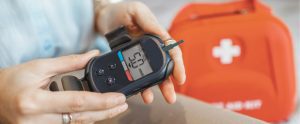By Andrea Hayes, MD, F.A.C.E.
 As a resident of Southwest Florida who sheltered in place during Hurricane Ian, I experienced firsthand managing my own Type 1 diabetes while dealing with a natural disaster. As we approach the peak of another hurricane season, I think people with diabetes or any other chronic condition should think through the potential disruptions they may experience and plan to help minimize a storm’s potential impact on managing their disease.
As a resident of Southwest Florida who sheltered in place during Hurricane Ian, I experienced firsthand managing my own Type 1 diabetes while dealing with a natural disaster. As we approach the peak of another hurricane season, I think people with diabetes or any other chronic condition should think through the potential disruptions they may experience and plan to help minimize a storm’s potential impact on managing their disease.
Loss of Power, and Medicines
People with chronic disease face additional challenges when impacted by a natural disaster. It never occurred to me that some pharmacies would sustain such destruction and loss of power that many refrigerators of insulin were trashed and lost. If a person didn’t have a backup stockpile and if their own insulin was destroyed or lost, urgent replacement was difficult.
As individuals with diabetes, it is crucial to take extra precautions when preparing for a natural disaster to ensure your health and safety. Power outages, limited access to medical facilities, and disrupted routines can pose unique challenges. If you plan to ride out a storm, you’ll need to plan for your supplies, food, potential power outages and how you’re going to communicate with others. If you need to evacuate, you’ll need a plan for that, as well.
Build an Emergency Supply Kit
Make sure you have an emergency supply kit specifically tailored to your diabetes needs. This kit should include:
Diabetes Supplies: Pack at least a two-week supply of all necessary diabetes medications, including insulin (if applicable), oral medications and blood glucose monitoring supplies. Ensure you have extra batteries for your glucose meter and a sufficient number of lancets and test strips.
Glucose-Raising Products: Keep fast-acting carbohydrates such as glucose tablets, juice boxes, or hard candy in your kit to treat hypoglycemia (low blood sugar).
Cooler and Ice Packs: Invest in a cooler and ice packs to maintain the temperature integrity of your insulin. Pre-freeze additional ice packs and label them for quick access.
Plan for Your Food Needs
You need to assume that your food supply may be disrupted. Make sure you have what you may need during this time:
Non-Perishable Food: Stock up on non-perishable food items that are suitable for managing diabetes, such as canned fruits and vegetables, whole grain crackers, nuts, and protein-rich foods like canned tuna or chicken.
Water: Ensure an ample supply of clean water for drinking and hygiene purposes. Store at least one gallon of water per person per day for a minimum of three days.
Power Outages are Likely
Losing your power, even for a short time, can pose problems. You should have:
Backup Power Sources: If you use an insulin pump, consider having a backup power source, such as a portable power bank or an alternate insulin delivery system, like insulin pens or syringes. Consult your healthcare provider for guidance on temporary changes to your diabetes management plan.
Insulin Storage: To keep your insulin cool during a power outage, place it in an insulated bag or cooler with frozen ice packs. Avoid direct contact between the insulin and the ice packs to prevent freezing. Insulin exposed to extreme heat or freezing temperatures may lose its effectiveness.
Keep Essential Documents With You
Emergency Contacts: Create a list of emergency contacts, including your healthcare provider, pharmacy, and nearby hospitals. Keep a hard copy in your emergency kit and save these contacts in your phone.
Medical Identification: Wear a medical identification bracelet or carry a card stating that you have diabetes. In case of an emergency, this will alert first responders and aid in appropriate care.
Medical Information: Write down critical information about your diabetes, including medication dosages, allergies, and any pre-existing conditions. Keep a copy in your kit and share this information with a trusted family member or friend outside the affected area.
Prescriptions and Medical Records: Photocopy your prescriptions and store them in your emergency kit. Additionally, make digital copies of your medical records and store them securely in the cloud or on a USB drive.
Prepare for a Potential Evacuation
You’ll need to keep abreast of the latest developments regarding potential evacuation orders, including your own.
Emergency Alerts: Stay informed about approaching storms through local news channels, weather apps, or a NOAA weather radio. Sign up for emergency alerts and follow the instructions provided by local authorities.
Evacuation Routes: Know the designated evacuation routes in your area and plan your journey accordingly. If you require assistance, contact local emergency management agencies to arrange transportation and accommodations.
Hurricanes and other natural disasters can disrupt our daily routines and pose additional challenges for people managing diabetes. By taking proactive steps to prepare for emergencies, you can safeguard your health and well-being. Please stay safe and stay prepared!
Andrea Hayes, MD received her Type 1 diagnosis at age 15. She is a board-certified endocrinologist who has been in practice for 25 years. She offers prompt appointments for patients in home, local office or via telehealth.
NAPLES DIABETES CONCIERGE
For more information, call 239-641-8199 or visit: naplesdiabetesconcierge.com








